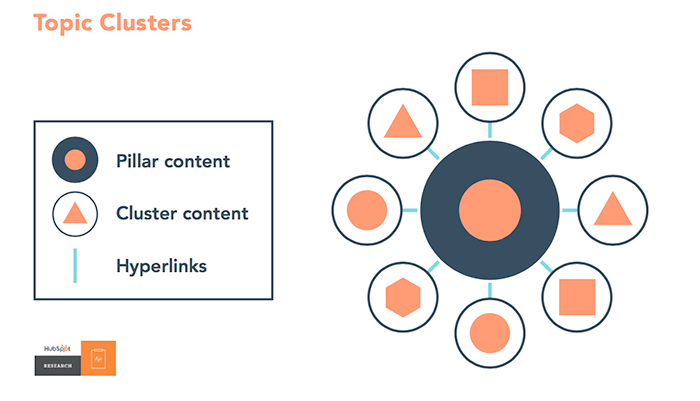Topic clusters are a strategy for search engine optimization and content marketing. The approach — organizing a site’s content around topics and subtopics — can be effective if you choose the right clusters.
“Years ago, people posed fragmented keyword queries to search engines to find answers to their questions. Nowadays, most are comfortable posing complex questions to a search engine, and they expect an accurate and timely result,” wrote Mimi An, in a 2017 HubSpot report.
“Searchers who want a specific answer also use many different phrases in their queries. And now search engines are smart enough to recognize the connections across queries. Algorithms have evolved to the point where they can understand the topical context behind the search intent, tie it back to similar searches they have encountered in the past, and deliver web pages that best answer the query.”

Topic clusters are an SEO and content marketing strategy. Each cluster is organized around a pillar page with many subtopic pages. Source HubSpot.
Thus, marketers can develop topic clusters that use internal and external links to demonstrate expertise in a particular topic. That topic should be something that is general, but not so broad that your business will not be able to rank for it.
Your topic should be encapsulated in very few words. Think about phrases like “vegan shoes,” “electric bikes,” or “beard grooming.”
This can be more difficult than it sounds. If I asked you to come up with five topics for your business, could you do it?
What follows is a process I’ve used to create retail topic clusters.
Step 1: Identify Target Customers
Your business may already have customer personas or a series of customer profiles. If that is the case, start with these. If not, do a bit of work to identify your target customer.
Who are those customers? How old are they? Why did they buy a product from your business? Why do they want or need your products? How did they learn about your store or your products?
Your research could take a few forms. You may choose to survey customers, hold a focus group, or simply interview a handful of your best customers.
During an interview or survey, identify some of the reasons your audience of potential customers might look for your product. Let’s imagine that you are interviewing a customer from your online vegan shoe shop.
“My name is Steve Brown, and I am a proud owner of four pairs of your vegan shoes,” your imagined customer says. “I didn’t start out to be a vegan. I was having a lot of knee pain, and so I was looking on Google for possible remedies. I found a study showing that meat, particularly fatty red meat, was the number one cause of joint pain. So I stopped eating it. Cold turkey so to speak.”
“I had been a meat and potatoes guy my whole life. So one of my big problems was that I didn’t know what to cook. I started looking for vegetarian recipes online, and eventually, I found myself in a vegan recipe group on Facebook.”
“I was finding great recipes, loving my new diet, and within a month my knee pain was completely gone. But I was also learning about veganism. I started to understand how meat production impacts the environment. I learned that it was unsustainable long term. I also heard stories about how meat processing works. It really turned me off. So I committed to doing my part.”
“That’s when I started looking for vegan shoes, clothing, and similar products. I wanted comfortable, wearable shoes that, frankly, felt like and looked like the shoes I have always worn, but that are made with sustainable, environmentally-friendly, and vegan materials.”
Step 2: List Customers’ Needs
Using customer profiles or personas, develop a list of needs and wants. What are the things that are important to your audience of potential customers?
Returning to the imagined customer statement above, what might be some of his needs and wants? Here is a portion of the list I brainstormed.
- Stop animal processing.
- Use sustainable products.
- Have good looking shoes.
- Have comfortable clothing and shoes.
- Have familiar shoes.
- Have a sense of contributing to a cause.
Repeat this step for each customer profile or persona. You may end up with a pretty long list.
Step 3: Organize into Broad Topics
Now it is time to start organizing the list of needs and wants into potential topics. This step is about finding similar items on your list.
For example, things like “stop animal processing,” “use sustainable products,” and “have a sense of contributing to a cause” are lifestyle choices. They focus on something outside of oneself.
Apply a similar organizational exercise for the list of wants and needs generated from your company’s customer profiles or personas.
Step 4: Use Keyword Research
The final step in the process of choosing topics for your SEO and content marketing topic cluster strategy is to validate your proposed topic with keyword research.
This doesn’t necessarily mean putting your topic idea into Ahrefs or SEMrush to see how many monthly queries it gets. Rather, it means understanding how your topic and its many subtopics might work together to position your business as the expert in, say, “the vegan lifestyle.”
Starting with the list of wants and needs, create a list of keywords to target under the topic of “vegan lifestyle.” This list collectively could represent more than 100,000 monthly searches, and, perhaps, a topic cluster that will attract, engage, and retain customers.